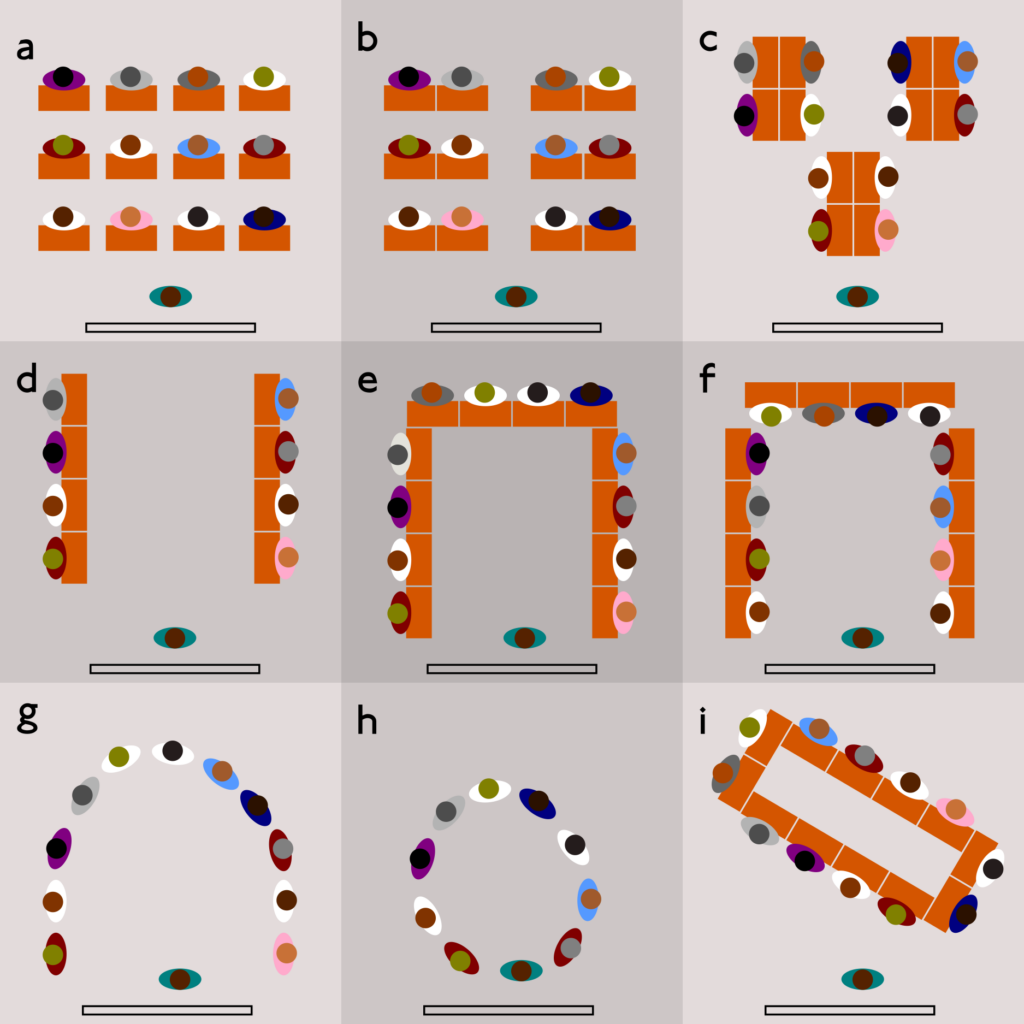For more tips and advice about CELTA, click here.
Classroom Organisation
Join my telegram channel for teachers.
Depending on your teaching context, you may have more or less control over the classroom environment. However, the organisation of the classroom can have an enormous impact on the success of a lesson.
Interaction Patterns
When planning activities for students, it is important to keep in mind the interaction that will take place. By doing so, we can set up our classrooms to encourage this interaction (and thus learning) to take place. Generally, the possibilities are (these abbreviations are often used in lesson plans):
- Teacher to all students (T-Ss)
- Students working individually (Ss)
- Students discussing in pairs (S-S)
- Students discussing in groups (S-Ss)
- Students to teacher (Ss-T)
- Whole class discussion (WC)
- Teacher to student interaction is typically used for giving instructions, explaining language and giving feedback. It can also be used to give models of language and motivate students.
- Students often work individually on listening, reading and writing activities in addition to some vocabulary and grammar exercises. Students may also find some thinking time helpful before a speaking activity (or reflection time afterwards).
- Most speaking activities involve pairs of students such as discussion questions and role plays.
- As with pair work, group work is typically used by teachers in speaking activities.
- The most likely activity here is a drilling activity (students repeat after the teacher). This is not the only way drilling can take place however (try here for some more ideas).
- Whole class discussions are useful to lead into a topic or to find out what students discussed in pair or group work.
While all of these interaction patterns have a place in a language lesson, student to student interaction (i.e. pair and group work) should dominate. This ensures that students get the maximum opportunity to produce language.
Student to student interaction can be maximised in a number of ways:
- keeping instructions and explanations short;
- giving students opportunities to check their answers to exercises in pairs;
- changing activities so that they involve speaking;
- involving more pair discussion questions and role plays;
- using peer drilling activities;
- turning whole group discussions into paired discussions.
Seating Arrangements
Look at the classroom seating configurations. Which of these may be best for (you may pick more than one):
- large classes (20+)
- a business English class in a company’s offices
- a computer-aided lesson
- pair work
- group work
- an exam
- whole group discussion

- Depending on the size of the room, ‘a’ or ‘b’ may be the only possible options for a large class. However, ‘c’ may also be possible.
- Depending on the company and size of the group, the most appropriate may be ‘i’ as it is close to the board room set up that students are used to.
- Some language schools invested in computer labs which were set up something like ‘f’. However, this configuration may still be useful today. By having students push desks to the edge of the room, space is created in the centre for work involving movement.
- All of the configurations except ‘a’ easily allow pair work.
- Configurations ‘c’ and ‘i’ most obviously allow for group work. The others require students to move into groups.
- Configuration ‘a’ is the best for a test since it makes copying off a neighbour or talking more difficult.
- Several configurations aid whole class disussion including ‘e’, ‘g’, ‘h’ and ‘i’. The best of these is ‘h’ as the teacher joins the students on the same level. This minimises the disruptive impact a teacher’s authority may have on student discussion. However, ‘i’ would be equally good, if the teacher sat at the main table.
Common Problems
(a) I have a group of three students. When I ask them to work together they always try to involve me in their discussion.
(c) I have 6 elementary students. We tried to do pair work, but it didn’t work. The students didn’t know what to say. So we do everything as a whole class so I can support each person.
(b) I had a new student join my class recently. I wanted them to work in pairs so I asked a student to move next to them. The student refused.
(d) My students often sit next to their friends. Two of them often just resort to Japanese when I tell them to work in pairs.
a. Students often want to hear their teacher’s opinion. This can be laziness, as when the teacher is speaking they are not. More likely however they would just like an extra model, or more ideas. The risk of this can be reduced however by a technique called spatial ancohoring. Simply set up two chairs for you – one close to the group and one further away. After setting up the activity, move to the chair further away. This sends the signal that you are removing yourself from that discussion.
b. Generally, adult students are likely to do what their teacher asks. Nevertheless you can reduce the risk of such a confrontation by regularly moving students around (particularly in the beginning of a course). This can be done in a wide variety of ways, such as assigning letters.
c. Probably the teacher didn’t give students sufficient language to do the task. Or maybe the teacher didn’t give enough time for students to meet the challenge. In any event, the teacher’s course of action is unlikely to help. Instead, she should attempt pair work again.
d. There are a number of reasons why this might happen, such as the students not knowing what to do. Nevertheless, if this is a multilingual class it might be helpful to have the students work with others who do not speak their language. Splitting the pair (from time to time at least) may also help in a monolingual class.

